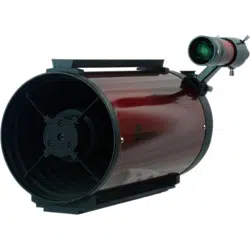Loading ...
Loading ...
Loading ...

6
included with the 10" RC. The cable from the battery
holder plugs into the DC power jack on the rear cell.
The fans can also be powered by other 12V DC
power supply, such as a iOptron PowerWeight
(#8128) or other portable battery. The DC plug is
5mm/2.1mm, center positive. We recommend turning
them off while actively observing or imaging to avoid
any effect on the view from vibration or blowing air.
Aligning Finderscope
The Photron system comes with a straight-through
finderscope, which has a quick-release bracket. The
finderscope mounting ring has three collimating
screws for precise alignment with the main scope
optics. The quick-release bracket slips into a dovetail
mounting base (mounting shoe) at the rear of the
scope during use.
First, look through main telescope tube and establish
a well-defined target (see focusing telescope section).
Tighten all lock knobs of your mount (declination,
right ascension, latitude and azimuth axes) so that
telescope’s aim is not disturbed. Then look through
the finderscope and adjust the three collimation
screws to center the object in the finderscope. Now,
objects located first with the finderscope will be
centered in the field of view of the main telescope.
Collimating the Ritchey-Chrétien
The optics in your new Ritchey-Chrétien optical tube
have been aligned and collimated at the factory.
However, rough handling during transit may cause
them to be knocked out of collimation and periodic
re-adjustments are required. A Cheshire eyepiece is
needed to check and adjust collimation. The rough
adjustments of primary and secondary mirrors can be
done indoors while a more rigorous start test needs
to be performed in the field.
Collimation Check
Get the telescope ready for collimation check in three
steps.
Remove any extension rings and attach the
focuser directly to the optical tube.
Set up the telescope in a well-lit room with the
telescope oriented horizontally, and point it at a
white or light colored wall.
Insert the Cheshire eyepiece into the focuser via
the included adapter and tighten the thumbscrew.
Make sure a bright source of light such as a
ceiling light or flashlight is aimed at the 45°
reflecting surface of the Cheshire.
Look through the Cheshire eyepiece, as shown in the
schematic below, a small black dot and a dark ring
within a larger bright circle can be seen. The dot is
the hole of the Cheshire eyepiece. The dark ring is
the center mark on the secondary mirror. And the
bright circle is the reflective 45-degree surface of the
Cheshire. The larger black circle outside that are the
secondary mirror and its holder.
If the scope is in good collimation, the black dot will
be dead center in the dark ring, which will in turn be
centered in the bright circle. If that’s the case, no
further adjustments to the secondary mirror will be
necessary. The optical axis is denoted by a thin white
circle on the outer edge. If this outline is a perfect
circle of uniform thickness, no further adjustments to
the primary mirror is needed.
Loading ...
Loading ...
Loading ...
